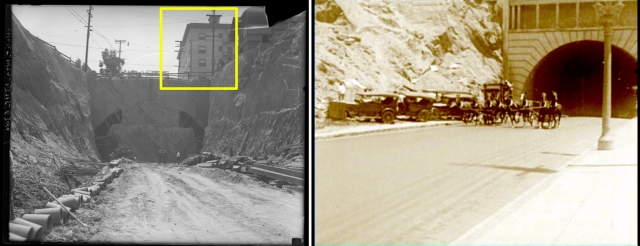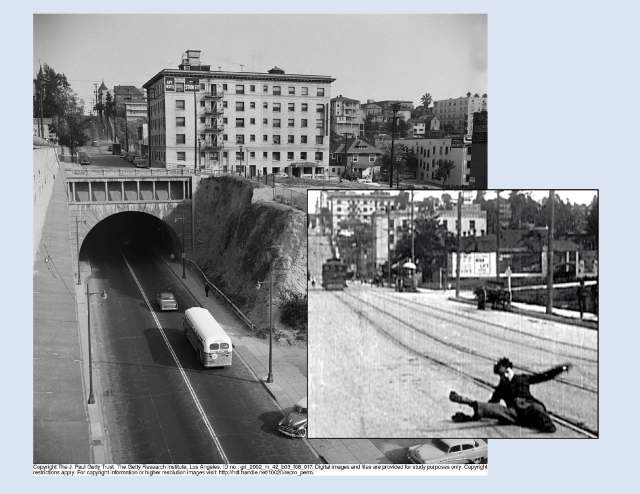
Caught in the Rain (1914) – looking east down 2nd Street from near Bolyston Street towards Bunker Hill.
Charlie Chaplin’s lucky 13th Keystone Studio movie Caught in the Rain was released May 4, 1914, one hundred years ago today. Although Chaplin credits this film in his autobiography as his first directorial effort, Chaplin biographer David Robinson suggests otherwise, due to the handwritten filmography Charlie sent to his brother Syd in August 1914, citing a prior film, Twenty Minutes of Love, as one of Charlie’s “own.”

Looking east towards the Hotel Stanley at the SE corner of 2nd and Flower. The left box marks the uphill slope of 2nd Street that was excavated reaching towards where the west portal of the tunnel (right box) was built at Flower St.
In either case, the clarity of Caught in the Rain (part of the Chaplin at Keystone collection from Flicker Alley, restored by Cineteca di Bologna and the British Film Institute in association with Lobster Films), provides a rare view of early Los Angeles, looking east down 2nd Street towards Bunker Hill, with the downtown Los Angeles core, out of sight, on the other side of the hill.

East view towards the west portal of the tunnel under construction, with the Hotel Stanley (box) looking down. A comparable view of the finished west portal appeared in the Mack Sennett comedy Circus Today (1926).
2nd Street had long been a major transportation bottleneck, as traffic from Hollywood and Glendale had to be diverted south from 2nd Street, around Bunker Hill, before entering the city. Construction of the 2nd Street Tunnel began in 1921, nearly seven years after Chaplin had filmed.
 The 2nd Street Tunnel was hailed as the greatest undertaking of its kind that Los Angeles had put through, both longer and wider than the city’s first tunnel, built at 3rd Street in 1900. Completion of the tunnel, which commenced April 11, 1921, was optimistically projected to take 15 months. By the time it officially opened on July 25, 1924, more than 39 months had passed. The photo at right shows the east portal during the tunnel’s opening celebration.
The 2nd Street Tunnel was hailed as the greatest undertaking of its kind that Los Angeles had put through, both longer and wider than the city’s first tunnel, built at 3rd Street in 1900. Completion of the tunnel, which commenced April 11, 1921, was optimistically projected to take 15 months. By the time it officially opened on July 25, 1924, more than 39 months had passed. The photo at right shows the east portal during the tunnel’s opening celebration.
 The trolley tracks appearing in the movie frame at top turned right (south) at Figueroa, to avoid going over the hill. The Hotel Stanley at the SE corner of 2nd and Flower Street (highlighted above and at left) overlooked the west portal of the completed tunnel.
The trolley tracks appearing in the movie frame at top turned right (south) at Figueroa, to avoid going over the hill. The Hotel Stanley at the SE corner of 2nd and Flower Street (highlighted above and at left) overlooked the west portal of the completed tunnel.
Chaplin at Keystone: Copyright (C) 2010 by Lobster Films for the Chaplin Keystone Project.

Update – a rare clear view of the back of the 2nd Street Tunnel and the Hotel Stanley Apartments matching in the Chaplin frame. (C) The J. Paul Getty Trust – The Getty Research Institute Los Angeles.
A comparable view today on Google Street View.



Lovely!
LikeLike